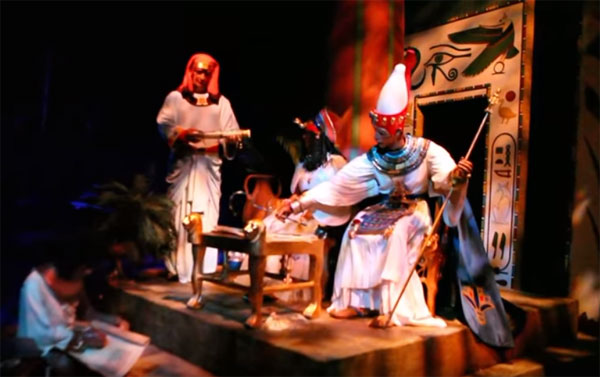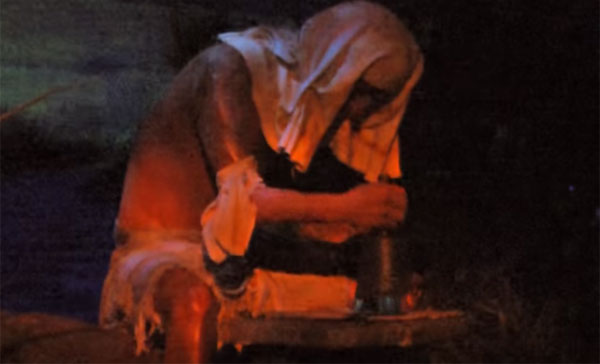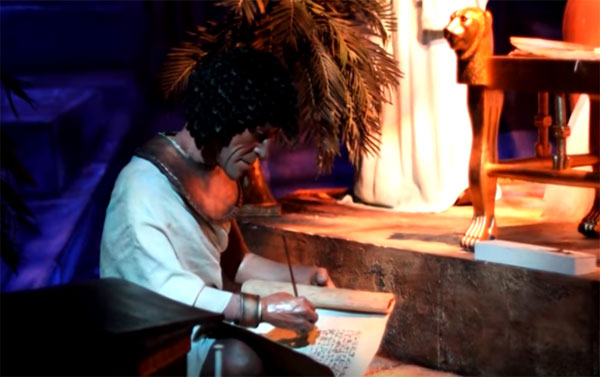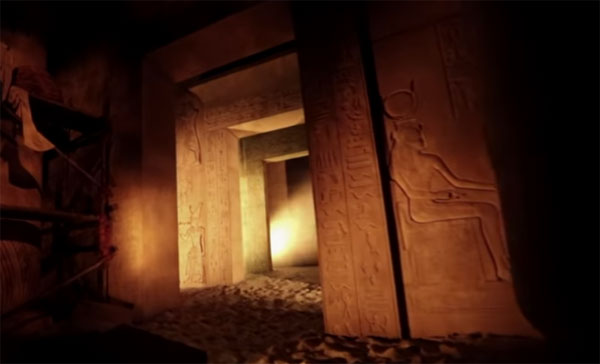
One of my favorite TV shows is Stargate SG-1, which uses ancient Egyptian icons as part of its sci-fi premise. Particularly with the feature film and the show’s early seasons, characters and decor were inspired by Egyptian legends and history. While using those sources as a guide, it was a fiction show that molded them into a fun adventure. The bar was much higher for Disney’s Imagineers when they created Spaceship Earth. They couldn’t just show Ancient Egypt and talk about the written language without a serious attention to detail within those scenes.
That willingness to avoid the easy route is one reason why I love the original EPCOT Center. These were not basic pavilions with an obvious look at history. The Imagineers went beyond what was needed in every scene. Guests can sense when an attraction involves so much care even if we don’t recognize every choice. This authenticity is so important to this third entry in my Spaceship Earth, Scene by Scene series.
In his book Secret Stories of Walt Disney World, Jim Korkis notes that the hieroglyphics in the Egyptian scene were authentic and would take several pages in a translation. Instead of just creating hieroglyphics that match the style, Disney went further and designed ones with a definite meaning. Korkis also points out that Anubis, Soker, and Thoth are all represented in this scene; nothing is thrown together. There is a reason why Spaceship Earth still works today.

The Creation of Written Language
One of the more significant changes to the current script occurs at the start of this scene. We have always passed an unknown Egyptian making paper out of papyrus on our left, but the narrators did not call attention to him. He looks a bit different now and is a lot more prominent. Dench specifically mentions this dedicated individual and the importance of this moment:
“Now, let’s move ahead to ancient Egypt, because something is about to happen here that will change the future forever. This unknown Egyptian pounding reeds flat is inventing papyrus — a sort of paper. Papyrus, in turn, creates better record keeping of plans, designs, and unfortunately taxes. But it also brings with it the dawn of great civilizations.”
Dench’s comment about taxes seems out of place and represents one of several ways this version tries to connect with our lives. It feels like pandering, but I understand the intent. I appreciate the way that Dench specifically describes what’s happening in the scene instead of talking in generalities. It represents a sharp contrast from how Jeremy Irons describes this scene in the previous version:
“Ages later, the Egyptians invented the first written communication – a complex language of hieroglyphic pictures and symbols. With the creation of papyrus scrolls, came the world’s first piece of paper. Now, without ever leaving their palaces, pharaohs could deliver proclamations and decrees to subjects across the land.”
Irons’ words are similar to ways that Cronkite and Perrin described this section. We still pass the scene with the pharaoh giving a proclamation in the current version, but the narration shifts to the creation of papyrus. This choice also ties more to a focus on innovation with Siemens as the sponsor.

A Pharaoh’s Proclamation
Our next stop is the memorable show scene with a seated pharaoh orating a message to his scribe as his wife fans herself nearby. It appears quickly after the papyrus but represents another step forward in how we communicate. The grand Egyptian leader is using paper to provide decrees to his people.
After I published this article, Neil Engel (art director for the 2007 version of Spaceship Earth at Walt Disney Imagineering) informed me that the pharaoh’s hat and collar necklace are duplicates of the ones made for Cedric Hardwicke in the movie The Ten Commandments. It’s a cool example of the ways the Imagineers pulled from a wide range of sources to put together the details of Spaceship Earth.
In my podcast interview with Peggie Fariss, she described the diligent efforts to bring authenticity to Spaceship Earth. Fariss worked as a show producer and was closely involved in research. The team contacted a professor of Egyptian history and hieroglyphics, Leonard DeGrassi, to help with ensuring the symbols had meaning. This approach was common during each step of the process to create the original Spaceship Earth. Disney employed a team of expert advisors like DeGrassi to ensure recreations were accurate.
According to Fariss, DeGrassi recorded the voice of the pharaoh and spoke the words of actual letter from that time period. This is another example where most guests would not realize that the Imagineers had gone to this level. However, it helps to ensure that nothing feels out of place throughout Spaceship Earth. Here is a rough translation from Fariss during the podcast of the original version: “You are my representative and people look to you, and I expect of you the highest performance.” Knowing this background makes me look at this scene in a new way.

Quick, Effective Transitions
Prior to the pharaoh scene, I love the sense of perspective from the walls that you pass on the right side of the vehicle. It’s easy to imagine that a lot more exists behind that opening, and we are easily transported from the Cro-Magnon scene to Egypt. There appear to be multiple spaces within this passageway, and scaffolding on the left side makes it seem even larger.
These transitions are crucial to the success of Spaceship Earth, particularly as the pace increases during the second half. Scenes appear in rapid succession, and it’s hard to process everything. At the end of the Egyptian scene, we pass under an intricate structure that serves as a marker for our movement into the Phoenician space. Recognizing more details is another reason why I’m enjoying this process of digging further in this series.
Next time, our journey through the history of communication reaches an important milestone. We’ll thank the Phoenicians and learn about their contributions to our past. Dench coins a slogan that newer Disney fans may cite as their favorite part of the attraction. Our slow-moving journey through time is only getting started, and many achievements remain on the horizon.
Sources: INTERCOT, Martin’s Videos, Mouseplanet, Secret Stories of Walt Disney World by Jim Korkis
Related Articles: Ancient Egyptians
Spaceship Earth, Scene by Scene: The Introduction
Spaceship Earth, Scene by Scene: The Cro-Magnon
Five Steps to Enhance Spaceship Earth
Five Reasons the Future World Concept Still Works
This post contains affiliate links. Making any purchase through those links supports this site. See full disclosure.



Leave a Reply